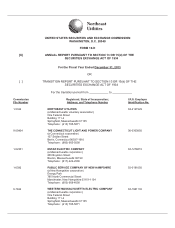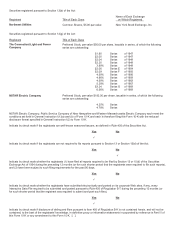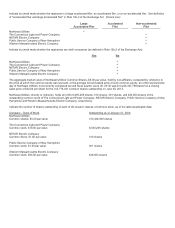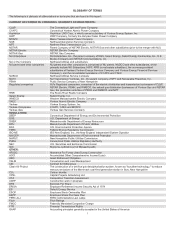Eversource 2013 Annual Report Download - page 16
Download and view the complete annual report
Please find page 16 of the 2013 Eversource annual report below. You can navigate through the pages in the report by either clicking on the pages listed below, or by using the keyword search tool below to find specific information within the annual report.
4
A summary of CL&P’s retail electric GWh sales and percentage changes for 2013, as compared to 2012, is as follows:
2013
2012
Percentage
Change
Residential
10,314
9,978
3.4 %
Commercial(1)
9,770
9,705
0.7 %
Industrial
2,320
2,426
(4.4)%
Total
22,404
22,109
1.3 %
(1) Commercial retail electric GWh sales include Streetlighting and Railroad retail sales.
Rates
CL&P is subject to regulation by PURA, which, among other things, has jurisdiction over rates, accounting procedures, certain
dispositions of property and plant, mergers and consolidations, issuances of long-term securities, standards of service and construction
and operation of facilities. CL&P's present general rate structure consists of various rate and service classifications covering
residential, commercial and industrial services. CL&P's retail rates include a delivery service component, which includes distribution,
transmission, conservation, renewables, CTA, SBC and other charges that are assessed on all customers. Connecticut utilities are
entitled under state law to charge rates that are sufficient to allow them an opportunity to recover their reasonable operation and capital
costs, to attract needed capital and maintain their financial integrity, while also protecting relevant public interests.
Under Connecticut law, all of CL&P's customers are entitled to choose their energy suppliers, while CL&P remains their electric
distribution company. For those customers who do not choose a competitive energy supplier, under SS rates for customers with less
than 500 kilowatts of demand, and LRS rates for customers with 500 kilowatts or more of demand, CL&P purchases power under
standard offer contracts and passes the cost of the power to customers through a combined GSC and FMCC charge on customers’
bills.
CL&P continues to supply approximately 56 percent of its customer load at SS or LRS rates while the other 44 percent of its customer
load has migrated to competitive energy suppliers. Because this customer migration is only for energy supply service, it has no impact
on CL&P’s delivery business or its operating income.
The rates established by the PURA for CL&P are comprised of the following:
• An electric generation services charge, which recovers energy-related costs incurred as a result of providing electric
generation service supply to all customers that have not migrated to competitive energy suppliers. This charge is adjusted
periodically and reconciled semi-annually in accordance with the directives of PURA.
• A distribution charge, which includes a fixed customer charge and a demand and/or energy charge to collect the costs of
building and expanding the infrastructure to deliver power to its destination, as well as ongoing operating costs to maintain
such infrastructure.
• A federally-mandated congestion charge, or FMCC, which recovers any costs imposed by the FERC as part of the New
England Standard Market Design, including locational marginal pricing, locational installed capacity payments, and any costs
approved by PURA to reduce these charges. This charge also recovers costs associated with CL&P’s system resiliency
program. This charge is adjusted periodically and reconciled semi-annually in accordance with the directives of PURA.
• A transmission charge that recovers the cost of transporting electricity over high voltage lines from generating plants to
substations, including costs allocated by ISO-NE to maintain the wholesale electric market.
• A competitive transition charge, assessed to recover stranded costs associated with electric industry restructuring such as
various IPP contracts. This charge is reconciled annually to actual costs incurred and reviewed by PURA, with any difference
refunded to, or recovered from, customers.
• A system benefits charge established to fund expenses associated with: various hardship and low income programs; a
program to compensate municipalities for losses in property tax revenue due to decreases in the value of electric generating
facilities resulting directly from electric industry restructuring; and unfunded storage and disposal costs for spent nuclear fuel
generated before 1983. This charge is reconciled annually to actual costs incurred and reviewed by PURA, with any
difference refunded to, or recovered from, customers.
• A Renewable Energy Investment Fund charge, which is used to promote investment in renewable energy sources. Funds
collected by this charge are deposited into the Renewable Energy Investment Fund and administered by Connecticut
Innovations. The Renewable Energy Investment Fund charge is set by statute and is currently 0.1 cent per kWh.
• A conservation charge, comprised of a statutory rate established to implement cost-effective energy conservation programs
and market transformation initiatives, plus a conservation adjustment mechanism charge to recover the residual energy
efficiency spending associated with the expanded energy efficiency costs directed by the Comprehensive Energy Strategy
Plan for Connecticut.
























